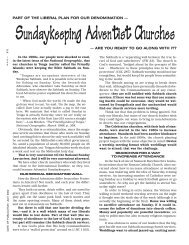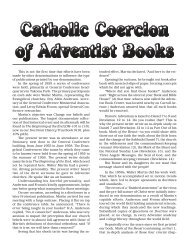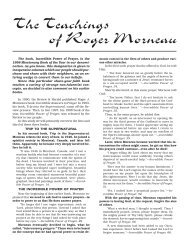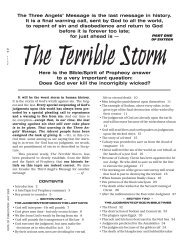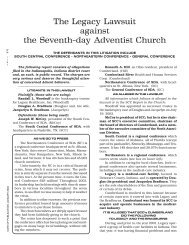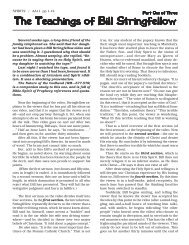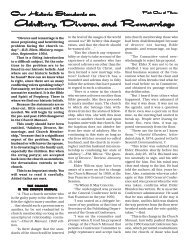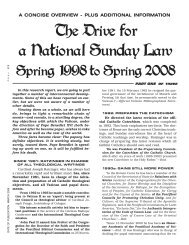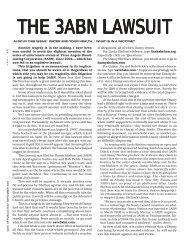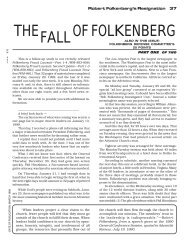The Apocrypha.pdf - SDADefend
The Apocrypha.pdf - SDADefend
The Apocrypha.pdf - SDADefend
Create successful ePaper yourself
Turn your PDF publications into a flip-book with our unique Google optimized e-Paper software.
<strong>Apocrypha</strong> / 19<br />
<strong>The</strong> <strong>Apocrypha</strong><br />
W<br />
M<br />
1<br />
0<br />
0<br />
5<br />
DATE OF PUBLICATION: JANUARY 2001<br />
<strong>The</strong>re are those among us who think it is necessary<br />
for the people of God, in these last days, to<br />
study the <strong>Apocrypha</strong>. At the request of friends,<br />
this brief overview has been prepared in order to<br />
save our people a lot of work. After reading this,<br />
your curiosity about the <strong>Apocrypha</strong> will very likely<br />
be exhausted. How thankful we can be that there<br />
is so much beautiful light and truth in the Bible<br />
and Spirit of Prophecy. In strong contrast, the<br />
<strong>Apocrypha</strong> is very, very empty.<br />
With the exception of 1 Maccabees (a valid historical<br />
account), the <strong>Apocrypha</strong> is not worth reading.<br />
THE INTERTESTAMENTAL PERIOD<br />
<strong>The</strong> Old Testament Scriptures were completed<br />
when Malachi penned his book, about the year 400<br />
B.C. From that time, down to the birth of Christ in 4<br />
B.C., is about 400 years. During those years of Scriptural<br />
silence, there was a lot of activity in Palestine,<br />
both political and written.<br />
From the conquest of Palestine by Alexander the<br />
Great (332 B.C.) to the destruction of the Temple (A.D.<br />
70), there was considerable religious and political activity.<br />
Four events immensely affected the Jewish<br />
people: (1) the Babylonian captivity (605-538 B.C.),<br />
(2) the uprising under Antiochus Epiphanes (c.175<br />
B.C.), (3) the destruction of Jerusalem and its Temple<br />
(A.D. 70), and (4) the Bar Cocheba revolt (A.D. 132-<br />
135).<br />
Because of one or more of those events, many<br />
uninspired Jewish writings were produced. <strong>The</strong>se<br />
writings include the <strong>Apocrypha</strong>, the Pseudepigrapha,<br />
and the writings of the Qumran community of Essenes.<br />
We will briefly look at each of these.<br />
1 - THE APOCRYPHA<br />
<strong>The</strong> term, “<strong>Apocrypha</strong>,” means “something hidden”<br />
and usually refers to a group of writings that<br />
appeared in the Greek (Septuagint) translation of the<br />
Old Testament; but these were never accepted in the<br />
Hebrew canon. Both Jews and Christians always recognized<br />
that the <strong>Apocrypha</strong> was not divinely inspired.<br />
<strong>The</strong> <strong>Apocrypha</strong> is several uninspired books which<br />
were added to the Septuagint (the Greek translation<br />
This study is taken from one chapter in our<br />
book, <strong>The</strong> King James Bible and the Modern<br />
Versions, which is currently included in installments<br />
in our monthly Information Packs.<br />
of the Hebrew Old Testament) about a hundred years<br />
before the birth of Christ.<br />
Because the <strong>Apocrypha</strong> contains several Roman<br />
Catholic teachings, the papacy requires every faithful<br />
Catholic to accept the <strong>Apocrypha</strong> as fully inspired.<br />
Not to do so, according to a decree of the Council of<br />
Trent (April 18, 1546), is to be guilty of a mortal sin.<br />
Oddly enough, it was not until that date that the<br />
Vatican ever ruled that the <strong>Apocrypha</strong> was divinely<br />
inspired!<br />
When the 16th-century Reformation began, it took<br />
time for the Protestants to successfully part with many<br />
of the errors and myths of Romanism. For this reason,<br />
some of the earliest Protestant Bibles had the<br />
<strong>Apocrypha</strong> in them,—although Christians have never<br />
accepted those writings as inspired.<br />
Interestingly enough, Jerome only included the<br />
<strong>Apocrypha</strong>l books in his Latin Vulgate at the insistence<br />
of the pope. Jerome did not believe they were<br />
divinely inspired.<br />
WHY CHRISTIANS REJECT<br />
THE APOCRYPHA<br />
<strong>The</strong>re are several very good reasons why Christians<br />
do not accept the <strong>Apocrypha</strong> as divinely inspired<br />
writings:<br />
1 - <strong>The</strong> <strong>Apocrypha</strong>l books are not included in the<br />
Hebrew canon of Scripture.<br />
2 - Though they are included in the Septuagint<br />
(the Greek translation of the Old Testament), Jesus<br />
never quoted from them.<br />
3 - <strong>The</strong> early Christian church totally rejected<br />
them from the canon.<br />
4 - <strong>The</strong> writer of 1 Maccabees recognized that there<br />
was no prophet among the Jews at that time (1 Maccabees<br />
4:46; 9:27; 14:41).<br />
5 - <strong>The</strong>y teach false doctrines:<br />
• An angel says of the smoke of a burning fish<br />
heart that it “driveth away all kinds of devils.”<br />
• God is urged, “Hear now the prayer of the dead<br />
of Israel” (Baruch 3:4).<br />
• “It is therefore a holy and wholesome thought<br />
to pray for the dead, that they may be loosed from<br />
sins” (2 Maccabees 12:43-45).<br />
6 - <strong>The</strong>y contain major historical and geographical<br />
errors.<br />
7 - Josephus, contemporary of John the Revelator,<br />
mentions the <strong>Apocrypha</strong>, but never considers it<br />
inspired.
2 Waymarks<br />
8 - Philo Judaeus, Jewish leader at Alexandria<br />
during the time of the apostles, left a large collection<br />
of writings and quoted extensively from the Old Testament—but<br />
never from the <strong>Apocrypha</strong>.<br />
9 - <strong>The</strong>y lack the high spiritual tone and general<br />
excellence of the Biblical writings.<br />
DESCRIPTION OF<br />
THE APOCRYPHAL BOOKS<br />
<strong>The</strong>se are the books that Roman Catholics are<br />
required to accept as inspired of God, on pain of mortal<br />
sin if they do not do so. What is in these books,<br />
that the Vatican is so intent on keeping them?<br />
HISTORICAL APOCRYPHAL BOOKS<br />
1 Maccabees—This is the only worthwhile book<br />
in the <strong>Apocrypha</strong>. It is fairly reliable history and covers<br />
the Maccabean revolt against Antiochus Epiphanes,<br />
from 175 to 135 B.C.<br />
This is an important historical book, and tells<br />
about the struggles of the Jews for religious and political<br />
liberty in the 2nd century B.C. <strong>The</strong> name is<br />
derived from Judas Maccabeus, the third son of Mattathias,<br />
a priest. (<strong>The</strong> word, “Maccabeus,” comes from<br />
the Hebrew word for “hammer.”)<br />
Written in Hebrew by a Palestinian Jew about 100<br />
B.C., it is our best source for the history of the first<br />
40 years of the Maccabean wars and gives a reasonably<br />
dependable account of the period from Antiochus<br />
Epiphanes (175 B.C.) to John Hyrcanus (c.135 B.C.).<br />
We are first told of events leading up to the Maccabean<br />
rebellion (1:1 to chapter 2); then about the military<br />
exploits of Judas (3:1-9:22) and his brothers, Jonathan<br />
(9:23-12:53) and Simon (13:1-16:24), who succeeded<br />
him in the ongoing struggle first for religious<br />
and political freedom. <strong>The</strong> emphasis of the book is<br />
on military activity; and little is told about the social,<br />
economic, and religious aspects of the period.<br />
2 Maccabees—This book is a mixture of history<br />
and legendary narratives, covering the period 175-<br />
160 B.C. An independent, divergent, and more elaborate<br />
account of events in 1 Maccabees 1-7, it was written<br />
by moralizing Jews about the 1st century B.C.<br />
and includes a variety of supernatural miracles which<br />
helped the warring Jews.<br />
ETHICAL APOCRYPHAL BOOKS<br />
Wisdom of Solomon—This book, written in<br />
Greek about 50 B.C. (probably at Alexandria), says<br />
that good living is best and sin and idolatry are wrong.<br />
<strong>The</strong> author claims to be King Solomon.<br />
Scholars who study ancient manuscripts declare<br />
that this book combines Old Testament teachings with<br />
Alexandrian ideas derived from Platonism and Stoicism.<br />
Ecclesiasticus (also called Wisdom of Jesus,<br />
the Son of Sirach)—<strong>The</strong> theme is also about good<br />
living. In some passages, the book sounds like Proverbs<br />
and Ecclesiastes.<br />
This research study is also included on pp. 190-195 of my book, <strong>The</strong> King James Bible and the Modern Versions.<br />
<strong>The</strong> most famous passage in Ecclesiasticus is a<br />
series of stories (chapters 44-50) beginning with the<br />
familiar words, “Let us now praise famous men.” Yet<br />
that is a concept foreign to true Scripture!<br />
<strong>The</strong>re are errors in both the Wisdom of Solomon<br />
and Ecclesiasticus.<br />
LEGENDARY APOCRYPHAL BOOKS<br />
Tobit—a legendary romantic narrative, said to<br />
have occurred during the Babylonian captivity and<br />
written about 200 B.C.<br />
According to this novel, Tobit was a Jew living in<br />
Babylon who became blind (chapter 1:2); and, then,<br />
after a quarrel with his wife, he wished he might die.<br />
At the same time, a widow named Sarah, living in<br />
Ecbatana in Media, had seven husbands slain on her<br />
wedding night by a demon named Asmodeus. So she<br />
also prayed that she might die. <strong>The</strong> angel, Raphael,<br />
was then sent to help them both (3). Raphael comes<br />
to Azaria and lies to him, saying he is a man named<br />
Azarias. Leading him to the Tigris River, Raphael has<br />
him catch a large fish (6), the intestines of which later<br />
help banish the demon, Asmodeus, and cure Tobit’s<br />
blindness. Arriving in Ecbatana, the angel helps Tobit<br />
find a lot of money; and he marries the woman who,<br />
according to the angel, was destined for him from all<br />
eternity (7:9). Yet Tobit was already married to another<br />
woman! Tobit then praises God (10-14).<br />
Judith—<strong>The</strong> story of the bravery of Judith, a Hebrew<br />
widow, written about 150 B.C.<br />
In this totally fictitious story, after the Jews returned<br />
from the Babylonian captivity, Nebuchadnezzar,<br />
the Assyrian king ruling from Nineveh, decided<br />
to punish the Jews for not assisting him in his<br />
conquest of Media. (As you know, Nebuchadnezzar<br />
was a Babylonian king, ruling from Babylon, and he<br />
was not alive after the Babylonian captivity.)<br />
Holofernes, his Assyrian general is said to have<br />
besieged the city of Bethulia; but, through trickery,<br />
Judith cuts off his head with his own sword while he<br />
is in a drunken stupor.<br />
Additions to Esther—Fictitious stories, written<br />
about 150 B.C., are inserted in various places in the<br />
book of Esther; and part of a chapter and six other<br />
chapters are added at the end of Esther. A total of<br />
107 verses are added.<br />
Additions to Daniel—<strong>The</strong>re are three of these.<br />
Here they are:<br />
<strong>The</strong> Prayer of Azariah and the Song of the<br />
Three Holy Children—<strong>The</strong> prayer of Abednego, plus<br />
the song of the three Hebrews, because their prayer<br />
in the fiery furnace was heard. This is the first of the<br />
additions to Daniel and is inserted between Daniel<br />
23 and 24 in the Septuagint, the Vulgate, and most<br />
Catholic Bibles.<br />
As the three stand inside the fiery hot furnace,<br />
Azariah prays for help so they will not die (1-22).<br />
<strong>The</strong>n, when it comes (23-28), the three praise God
W<br />
M<br />
1<br />
0<br />
0<br />
5<br />
<strong>The</strong> <strong>Apocrypha</strong><br />
for deliverance (29-68). Ignored is the fact that they<br />
had to be helped as soon as they were pushed into<br />
the fiery furnace!<br />
Susanna and the Elders—A story about how<br />
Daniel saved Susanna from being condemned to death<br />
as a result of false accusations.<br />
In the Vulgate, this religious romance follows the<br />
last chapter of Daniel and is numbered as chapter<br />
13. It apparently was written in Hebrew in the 1st<br />
century B.C.<br />
Two Jewish judges tried to seduce Susanna, the<br />
godly wife of Joakim, a prominent Babylonian Jew.<br />
When she refused, they accused her of adultery. Daniel<br />
rescued her by independently cross-examining each<br />
of the elders, proving their stories contradictory and<br />
fallacious.<br />
Bel and the Dragon—This consists of two fabulous<br />
stories, written probably in Hebrew during the<br />
1st century B.C. and included as chapter 14 of Daniel:<br />
(1) Daniel proves that Bel’s priests and their families<br />
ate food offered to an idol. (2) After Daniel kills a<br />
dragon, he is then put in the lions’ den.<br />
In the first story, the Babylonian priests of Bel<br />
(Marduk) have claimed that their heathen idol was<br />
eating the food presented to it. Daniel disproves this<br />
claim by sprinkling ashes on the floor, demonstrating<br />
that the 70 priests and their families would sneak<br />
in by a secret door and take the food.<br />
In the second story, a great dragon was being worshiped<br />
by the people. Daniel kills it by feeding it a<br />
concoction of pitch, fat, and hair, boiled together. <strong>The</strong><br />
creature bursts and dies. Because he did this, Daniel<br />
is cast (a second time) into a lions’ den for not one,<br />
but six days. While there, he is miraculously fed by<br />
Habakkuk, the prophet, who is flown by an angel from<br />
Judea to Babylon for this purpose.<br />
PROPHETIC APOCRYPHAL BOOKS<br />
Baruch—This book purportedly was written by<br />
Jeremiah’s scribe, Baruch, during the Babylonian exile.<br />
It is thought to have been written, in the first century<br />
A.D., by a Jew in order to warn his people that<br />
the destruction of Jerusalem (A.D. 70) happened because<br />
of the sins of the Jewish nation. <strong>The</strong> final chapter<br />
promises the restoration of Israel and predicts<br />
the humbling of all her oppressors.<br />
Letter of Jeremiah (also known as the Epistle<br />
of Jeremy)—This book is included at the end of<br />
Baruch in ancient manuscripts. But it is a separate<br />
production which non-Catholic scholars believe to<br />
have been written after the destruction of Jerusalem<br />
in A.D. 70, to encourage them to remain true to Judaism.<br />
In this manuscript, based on Jeremiah 10:11, the<br />
writer warns his people not to forsake Judaism, lest<br />
they experience another captivity.<br />
3<br />
2 - THE PSEUDEPIGRAPHA<br />
By order of the Council of Trent, the above books<br />
are all included in Roman Catholic Bibles. <strong>The</strong>re are<br />
also five other books which are called the Pseudepigrapha.<br />
Roman Catholics are not required to accept any<br />
of the following books, and they have never been considered<br />
canonical by any denomination.<br />
3 Maccabees—This book of seven chapters is<br />
clearly folklore; it tells the story of the victory of<br />
Ptolemy IV Philopator, over Antiochus the Great, at<br />
the Battle of Raphia (217 B.C.) in order to deliver the<br />
Jewish people.<br />
4 Maccabees—This brief book urges the Jews<br />
to practice temperance and self-control by studying<br />
the Torah.<br />
Prayer of Manasseh—You will recall that King<br />
Manasseh was carried to Babylon; and, while there,<br />
he repented and was restored to his throne (2 Kings<br />
21:1-18; 2 Chronicles 33:1-20).<br />
This Pseudepigraphal document, written in Hebrew<br />
about 150-100 B.C., purports to be Manasseh’s<br />
prayer while in captivity. It is not considered canonical<br />
even by Catholics.<br />
1 Esdras—Written by an Egyptian Jew about 150<br />
B.C., this book is often described as historical fiction.<br />
Neither Catholics nor Protestants accept it as<br />
canonical. 1 Esdras purports to tell more about portions<br />
of 2 Chronicles, Ezra, and Nehemiah.<br />
It is best known for its account (1 Esdras 3:5-<br />
4:63) of three young bodyguards of Darius I who, one<br />
day, sought the best answer to the question, What is<br />
the strongest thing in the world? <strong>The</strong> first said, “Wine<br />
is strongest.” <strong>The</strong> second said. “<strong>The</strong> king is strongest.”<br />
<strong>The</strong> third said, “Women are strongest, but truth<br />
is victor over all things.” At this, the people applauded<br />
him and cried, “Great is truth, and strongest of all.”<br />
Does that sound like anything worth reading? This<br />
event is supposed to have given Zerubbabel the opportunity<br />
to obtain from Darius the command to resume<br />
building on the Temple in Jerusalem (4:48-57).<br />
A point of confusion needs to be mentioned here.<br />
In Catholic Bibles, the books of Ezra and Nehemiah<br />
are called 1 and 2 Esdras. But, of course, the Pseudepigraphal<br />
books, 1 and 2 Esdras, are quite different!<br />
In the Latin Vulgate, 3 and 4 Esdras are included<br />
as an appendix to the New Testament, as is the Prayer<br />
of Manasseh.<br />
2 Esdras—This book apparently was written by<br />
Christians between A.D. 150 and 250. It speaks of<br />
the rejection of the Jews and the calling of the Gentiles<br />
(chapters 1-2) in chapter 1 and verse 30. This is<br />
similar to Matthew 23:37; chapter 1 and verse 37 is<br />
similar to John 20:29.<br />
Chapters 3-14 are supposed to have been written<br />
by someone named Salathiel, who is identified with<br />
Ezra. It is thought that the book was written by a
4 Waymarks<br />
Christian and named “Ezdras” in order to get the<br />
Jews to read it. At its end (14:48), Ezra is supposed<br />
to have been translated to heaven, without experiencing<br />
death.<br />
Jubilees—Written in Hebrew apparently by a<br />
Pharisee or an Essene about 125 B.C., Jubilees<br />
teaches that the coming Messianic kingdom will<br />
gradually develop until both man and nature will<br />
reach perfection, happiness, and peace. At that time,<br />
everyone will live a thousand years; and, at death, all<br />
will then go to heaven. A fragment of this work was<br />
discovered among the Dead Sea scrolls in Qumran<br />
Cave I.<br />
First Enoch (or Ethiopic Enoch)—This is a<br />
compilation, partly in Hebrew and partly in Aramaic,<br />
of the works of several authors who were Pharisees.<br />
It is called “Ethiopic Enoch” because our only source<br />
is an Ethiopian version.<br />
It has a variety of teachings, some contradictory,<br />
about the coming Messiah and his kingdom: It will<br />
be eternal on earth and in heaven and will begin after<br />
the last judgment (37-71); it will be eternal only on<br />
the earth, beginning after the last judgment (1-36); it<br />
will be temporary and on earth, and will be followed<br />
by the last judgment (91-104).<br />
<strong>The</strong> evil one is Azazel who “hath taught all unrighteousness<br />
on earth and revealed the eternal secrets<br />
which were (preserved) in heaven, and which men<br />
were striving to learn” (9:6).<br />
Second Enoch (Slovonic Enoch)—Extant only<br />
in a Slavonic version, this manuscript has some similarity<br />
to First Enoch, but also to early Christian literature.<br />
Part of it is thought to have been written by<br />
Christians in a later century A.D.<br />
Second Baruch—A compilation of several works,<br />
this book declares that men are saved solely by their<br />
works and that the Messianic kingdom is soon to be<br />
established; then Israel will be a world empire with<br />
Jerusalem as its capital. Probably written during the<br />
first or second century A.D., it is extant only in a<br />
Syriac version.<br />
Third Baruch—This book, probably written in<br />
the second century A.D., advocates a belief in seven<br />
heavens and three classes of angels who intercede<br />
for three classes of men.<br />
Fourth Ezra—Probably written about the end of<br />
the first century A.D., this book teaches that Israel is<br />
great, the Jews are God’s only people, the law was a<br />
special gift to them after its rejection by other worlds,<br />
and that God loves the Jews more than any other<br />
people.<br />
Testaments of the Twelve Patriarchs—This<br />
book, which may have been written by a Jew during<br />
the Maccabean rule, teaches that through the Jews<br />
all the Gentiles will be saved. <strong>The</strong> promised Messiah<br />
will come through the tribe of Levi, not Judah. Part<br />
of this book was found among the Dead Sea Scrolls<br />
in Qumran Cave I.<br />
Sibylline Oracles—This is a work comprised<br />
originally of 15 books and several fragments containing<br />
oracles developed by Jews and probably also<br />
Christian authors, from the 2nd century B.C. to about<br />
the 5th century A.D.<br />
Assumption of Moses—Probably written during<br />
the 1st century A.D. by a patriotic Jew, this work<br />
originally had two different books: the Testament of<br />
Moses and the Assumption. <strong>The</strong> author teaches that<br />
the ten tribes will return and rejoin Judah and Benjamin;<br />
and, eventually, Israel will be the greatest nation<br />
on earth.<br />
Psalms of Solomon—This is a collection of 18<br />
psalms which declare that Israel is righteous and all<br />
other nations are wicked. It probably was written in<br />
Hebrew in the first century B.C.<br />
3 - THE QUMRAN DOCUMENTS<br />
It is believed that the Jews who lived in the<br />
Qumran Community, near the Dead Sea (1st century<br />
B.C.-1st century A.D.), were Essenes. In addition to<br />
preparing copies of Old Testament books, they also<br />
wrote several original documents; only a few of these<br />
are complete enough to be useful.<br />
<strong>The</strong> Manual of Discipline—This is the most important<br />
of the non-Biblical books found at Qumran.<br />
It contains the rules and regulations of the group<br />
which had a democratic organization, but no private<br />
ownership of property or even money. Strict rules<br />
include making false or foolish statements, interrupting<br />
another’s speech, or sleeping during a meeting.<br />
Everyone was required to eat together. Initiation rituals,<br />
water purification rites, etc. are included. <strong>The</strong><br />
rules are similar to the Essene rules which were described<br />
by Philo and Josephus.<br />
<strong>The</strong> Habakkuk Commentary (1Qp Hab.)—<br />
Habakkuk 1 and 2 are said to be prophecies which<br />
were fulfilled in the times in which the writer lived.<br />
<strong>The</strong> War of the Sons of Light with the Sons of<br />
Darkness (1QM)—Rules of warfare are outlined,<br />
which the faithful Jews are to obey in their soon-coming<br />
war against evil forces.<br />
<strong>The</strong> Damascus Document—Discovered in a<br />
Genizah (manuscript storeroom) of a Cairo synagogue<br />
near the close of the 19th century, this document parallels<br />
rules and teachings found in the Manual of Discipline<br />
and Habakkuk Commentary.<br />
Consider how empty and dreary your life would<br />
be, if you did not have the precious Bible and Spirit<br />
of Prophecy! <strong>The</strong> Inspired Writings are your path<br />
to heaven. Stay on the path. Nothing else is safe.<br />
—vf<br />
More WAYMARKS - from ——————————<br />
PILGRIMS REST<br />
HCR 77, BOX 38A - BEERSHEBA SPRINGS, TN 37305 USA



